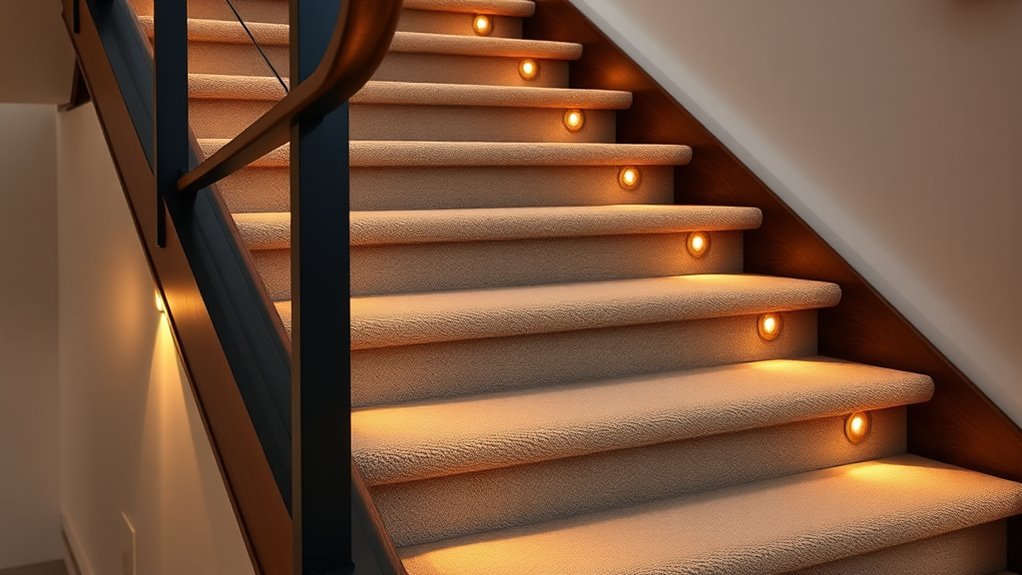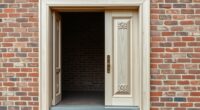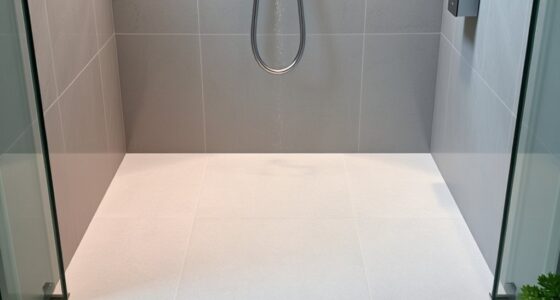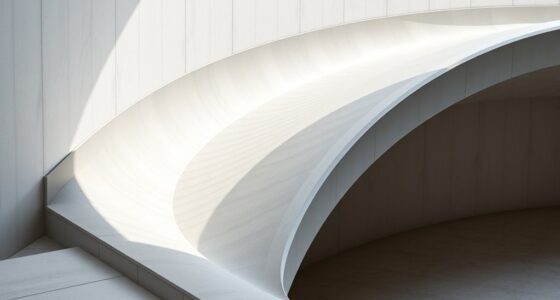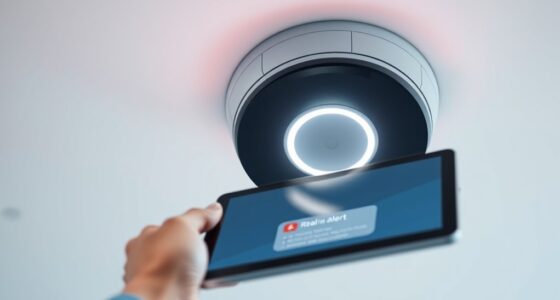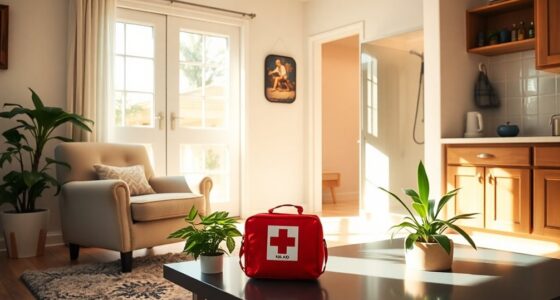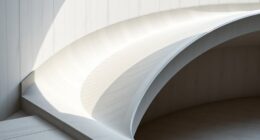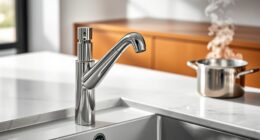To blend stair safety seamlessly with your decor, choose sleek, unobtrusive railings that provide support without overpowering the space, paired with subtle lighting like LED strips or recessed fixtures that illuminate each step without clutter. Use textured, slip-resistant treads that look stylish yet keep everyone safe. Properly integrated, these features enhance both safety and aesthetics. Keep exploring how to create a cohesive, secure staircase that doesn’t compromise on design.
Key Takeaways
- Use sleek, integrated railings that complement stair design while providing necessary support and safety.
- Incorporate subtle, unobtrusive lighting like LED strips or recessed fixtures for effective illumination without clutter.
- Select matching, durable treads with slip-resistant surfaces that blend seamlessly with the overall aesthetic.
- Ensure all safety features are discreet yet secure, avoiding visual clutter while maintaining compliance.
- Regularly inspect and maintain railings, lighting, and treads to ensure safety without compromising design harmony.
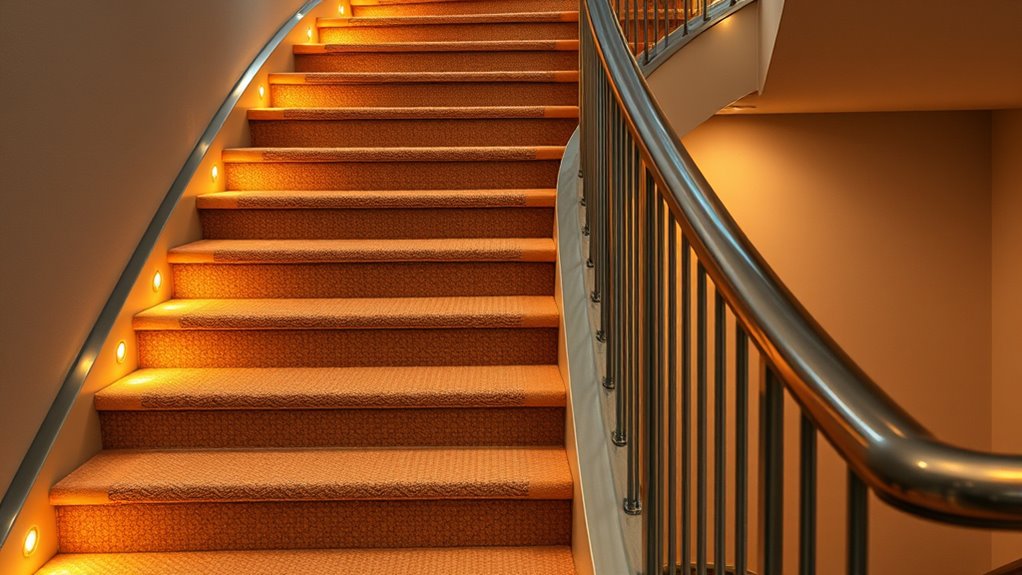
Have you ever considered how vital stair safety is in preventing accidents? It’s easy to overlook the details that keep stairs safe, but the truth is, small adjustments can make a significant difference. Properly blended safety features like railings, lighting, and treads don’t just improve aesthetics; they actively reduce the risk of falls and injuries. When you pay attention to these elements, you create a safer environment for everyone who uses the stairs. Both risk assessments and safety assessments should be conducted regularly to identify potential hazards and ensure compliance with safety standards. Railings are your first line of defense. They provide support and stability, especially for those who might struggle with balance or mobility. Ensure your railings are sturdy, at the right height, and continuous along the entire staircase. Loose or missing railings are a major hazard, so check them regularly for stability and secure attachment. The design should also prevent slipping or trapping fingers, which means smooth, rounded handrails are preferable. When you incorporate railings that extend beyond the top and bottom of the stairs, you give users something to hold onto at all critical points, reducing the likelihood of a fall. Lighting plays a pivotal role in stair safety, yet it’s often neglected. Adequate illumination eliminates shadows and dark spots that can obscure steps, making it easier to see each tread clearly. Install light fixtures that provide bright, even light on the stairs, and consider motion-activated lights in areas with low foot traffic. This way, you won’t have to worry about leaving lights on all the time, but the stairs will still be illuminated when needed. If your stairs are in a dimly lit area, adding LED strip lights along the handrails or under the nosing of each tread can further enhance visibility. Proper lighting doesn’t just prevent trips; it boosts confidence when ascending or descending, especially for elderly or visually impaired individuals. Treads are the foundation of stair safety. They need to be slip-resistant, uniformly sized, and well-maintained. Avoid worn or uneven surfaces, which can cause missteps. Add non-slip treads or adhesive strips if the existing surface becomes slick, especially in areas prone to moisture or spills. The depth and height of each step should be consistent to prevent tripping hazards. When you ensure the treads are secure and clearly visible, you make it easier for everyone to navigate the stairs confidently. Properly designed treads also help in distributing weight evenly, reducing wear and tear that could lead to dangerous breaks or loose steps over time.
Frequently Asked Questions
How Do I Choose the Best Railing Material for Durability?
To choose the best railing material for durability, consider options like stainless steel, which resists rust and corrosion, or aluminum, known for its strength and lightweight qualities. If you want a classic look, wrought iron offers durability with proper maintenance. Avoid softer materials like wood for high-traffic areas, as they wear quickly. Evaluate your climate, usage, and aesthetic preferences to select a material that withstands daily wear and tear.
What Are Modern Lighting Options for Stair Safety?
Imagine guiding your steps through a gentle glow—modern stair lighting options include LED strip lights along treads, recessed step lights, and motion-activated fixtures. These illuminate your path softly yet clearly, reducing trip hazards without harsh glare. You can even choose smart lighting that adjusts brightness automatically. With these options, your stairs become a safe, inviting pathway that blends seamlessly into your home’s aesthetic while keeping safety front and center.
How Can I Improve Slip Resistance on Existing Treads?
You can improve slip resistance on existing treads by adding textured or non-slip adhesive strips, which provide extra grip underfoot. Consider applying a clear anti-slip coating or paint designed for stairs to increase traction without changing the look. Regularly clean the treads to remove dust and debris that can cause slipping. Installing rubber mats or treads with built-in grip features also helps prevent accidents, especially in wet or high-traffic areas.
Are There Building Codes for Stair Safety in Rentals?
While it’s wise to guarantee safety, building codes for stair safety in rentals do exist. You’re generally required to meet standards for handrails, tread dimensions, and lighting, ensuring tenants’ well-being. Local regulations often specify these requirements, so it’s best to check with your city or state building department. Staying compliant not only safeguards your tenants but also protects you from potential liabilities, creating a safer environment for everyone.
What Maintenance Is Required for Stair Safety Features?
You need to regularly inspect your stair safety features, like railings, lighting, and treads, to guarantee they’re secure and in good condition. Tighten loose railings, replace flickering or burnt-out bulbs, and repair or replace worn or damaged treads promptly. Keeping these elements well-maintained helps prevent accidents. Schedule routine checks at least quarterly, especially in high-traffic areas, and address issues immediately to keep everyone safe on your stairs.
Conclusion
Remember, your stairs are more than just steps—they’re the bridge between safety and danger. Proper railings, lighting, and sturdy treads act as guardians guiding you safely upward and downward. When you care for these elements, you’re not just maintaining a staircase; you’re nurturing a symbol of stability and protection in your home. Approach your stairs with respect and vigilance, and they’ll always lead you safely, symbolizing a foundation of security you can rely on every day.
